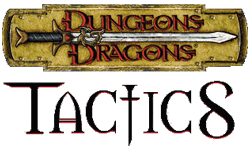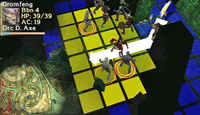|
|

|
PLATFORM
|
PSP
|
BATTLE SYSTEM
|

|
INTERACTION
|

|
ORIGINALITY
|

|
STORY
|

|
MUSIC & SOUND
|

|
VISUALS
|

|
CHALLENGE
|
Easy to Moderate
|
COMPLETION TIME
|
30-40 hours
|
|
OVERALL

|
Click here for scoring definitions
|
|
|
Dungeons and Dragons Tactics is the first D&D game for the PSP. Previews promised a tactical adventure in the vein of the tabletop game, including a strict adherence to the published rules. In short, a dream come true for fans.
The game has many flaws, one of which comes from its adherence to the rules. For a game that follows so many of the rules, several are forgotten, or mutated into ways that would make sense for the game. This tends to make the game confusing for long-time fans of the social game. The automatic application of metamagic feats, the immediate destruction of trolls on death, and the psionically-susceptible elementals are examples of this.
The player can create their own party to complete the game. A party is a group of up to six adventurers of typical D&D races and classes. The developers have also added a pair of new classes: the psion, a user of mental powers, and the psychic warrior, a fighter/psion hybrid. The lack of multi-classing and prestige classes is a definite minus. New party members can be hired at different times throughout the story and can be swapped into the party at any time between adventures.
The story is lackluster. The first character that is added to the party is the leader and all the story scenes will revolve around them. The rest of the party gets occasional lines, but are purely there as extras. The game puts little to no emphasis on the story, and it serves just as an introduction to each of the game's adventures. It is very easy to forget what must be done and very hard to care about it.
 A vicious melee unfolds.
A vicious melee unfolds.
|
|
The game is split up into many adventures. Each adventure is a standalone dungeon map that is split up into squares, as would be a battlefield map in a typical pen and paper session. The player must move the party from point A to point B using the typical D&D rules. Each character is moved separately and this gets very tedious. Movement could have been better done using a party formation feature with individual movement reserved for combat. This exploration is what slows down the game and makes it different from typical tactical RPGs.
Battles are highly tactical in this game, but with an interesting difference. The player knows how the game works. The rules are a (mostly) faithful adaptation of the written rules, so there is no guesswork. Everything can be looked up. Just like movement, battles are slow. It is easy to spend long periods of time watching the characters just stand there waiting for their next turn. Luckily, the game includes "chess mode". While this option is enabled, the characters don't animate when they perform actions, which greatly increases the speed of the game.
The game's interface is absolutely terrible. It is difficult to navigate, hard to find the desired information and lacks comparison between pieces of equipment. Simple tasks like inventory management fall to the wayside and leave the player frustrated and unwilling to do any kind of micro-management.
The game has some interesting music pieces, but the sound effects are rather boring. There is no voice work. The graphics are bland, as the backgrounds are uninteresting and the majority of the character models are horribly done. The only plus side here is the lighting--using light spells and torches really looks cool. Some spells have amazing special effects, but with chess mode on these are invisible.
 Do you see an Attack of Opportunity occuring?
Do you see an Attack of Opportunity occuring?
|
|
The challenge of the game comes from a few different areas. To begin, the rules are pretty complex and a newcomer to the D&D rules could be overwhelmed. It is not every day that a game requires the reading of a 300 page book to fully understand! While a passing knowledge of the rules will suffice, broader knowledge is pretty much required for full enjoyment of the title.
The choice of characters greatly enhances the challenge found in the game. A psion, once level eleven, breaks the difficulty of the game. A reliance on this tactic leads to very difficult battles later on, as enemies become immune to all non-melee attacks. A weak main character (such as a mage) can lead to many problems, as a killed leader spells defeat. The leader must really be careful not to be critically hit or the target of death magic.
The final element that affects the difficulty is the fact that the party can rest and save everywhere. This feature removes the need to conserve spells for when they will be useful and leads to the party just powering through every encounter.
Dungeons and Dragons Tactics is a very poor game. It is hard to play, hard to learn, hard to follow and hard on the eyes. The huge fluctuations in challenge don't help either. The lack of story, poor graphics, and horrible interface can be forgiven by diehard fans looking for a traditional D&D game, but for non-fans, this is a game that can definitely be missed.
Review Archives
|









